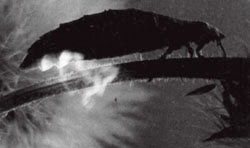Light ahoy!
 a new biotechnology device - bioluminescense - is now being exploited worldwide to detect microbial contamination in industries ranging from cosmetics to foodstuffs and to pharmaceuticals. About 2.5 billion such tests were globally performed last year, costing about us $4.14 billion, says Forest and Sullivan, the market research organisation in the us . But the new, rapid-testing methods account for only about 2.5 per cent of the testing.
a new biotechnology device - bioluminescense - is now being exploited worldwide to detect microbial contamination in industries ranging from cosmetics to foodstuffs and to pharmaceuticals. About 2.5 billion such tests were globally performed last year, costing about us $4.14 billion, says Forest and Sullivan, the market research organisation in the us . But the new, rapid-testing methods account for only about 2.5 per cent of the testing.
Fireflies, glow worms and the phosphorescence of the sea are the most common examples of bioluminescence, but the phenomenon is also observed in many animals, plants, fungi and bacteria. Living organisms produce light with an enzyme called luciferase.
Biotechnology companies have developed kits which use this enzyme to measure adenosine triphosphate (atp) - a naturally occurring chemical which fuels all biochemical reactions including luminosity.
A small volume of the substance is mixed with an enzyme reagent supplied with the kit. After standing for a few minutes, the sample begins to produce light. The intensity of the light is measured in a luminometer to give a measure of the atp present. This is extrapolated to give the number of microbes, or the total biological material present. This indicates whether bacteria, or other contaminants, are present in the sample.
Bioluminescence, however, has yet to find a significant application outside diagnostics and microbial testing. Gurdon Stewart, a professor at the University of Nottingham, uk , is a champion of its use in research. The gene which confers the ability for luminescence, can be engineered into any organism, says Stewart, thus enabling a researcher to follow the activity of a gene simply by the amount of light it produces.
The excitement of the bioluminescent technology lies in its ability to replace existing methods for detecting microbial contamination with cheaper and more rapid techniques. In many industries, it is tested by taking a swab from a surface or a sample of liquid spread over a sterile Petri dish. Then it is incubated until the cell colonies picked up by the swab or in the liquid sample grow large enough to be seen by the naked eye. This can take from two to seven days depending on the type of organisms present. The methodology has changed little during the last 100 years.
Chris Evans, a director of Celsis International, a uk-based biotechnology company, says, "If Louis Pasteur was alive today, he would feel quite at home in the modern microbiological quality assurance laboratory. Most of the techniques he used are still used today." The same results can now be achieved within a few minutes. Bioluminescent tests are not only quicker, but they are often more accurate than conventional methods.
Fleet Laboratories, a uk drug manufacturer, has been using Celsis detection systems for more than a year. The systems solve some basic production problems, says Tony Hook, commercial manager. "How do you know that someone has washed his hands? Conventionally you swab someone's hand and it would take three to four days to find out how clean they are. Now we can find out in a matter of minutes," said Hook.
The tests can incorporate filters to screen any extraneous biological material and measure the microbe numbers. In some cases, such as measuring the cleanliness of a surface, one only needs to know the amount of total biological material and filtration that is not used. Kits are now available for both requirements and the technology is getting easier to use.
There are now more than 40 companies which sell bioluminescence-based tests. In the commercially important area of microbiological quality assurance, there are only a handful of main players - Amersham, Biotrace, Celsis (all uk-based), and Lumac of the Netherlands.
